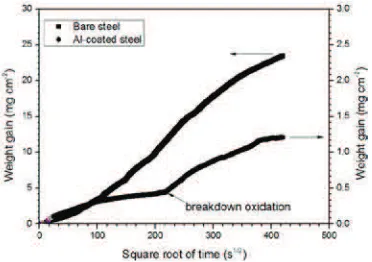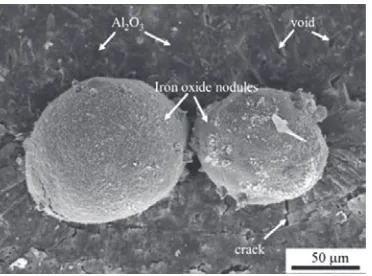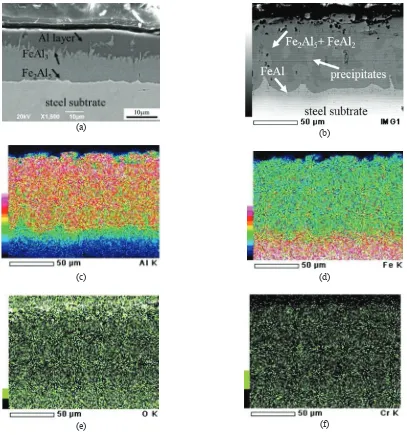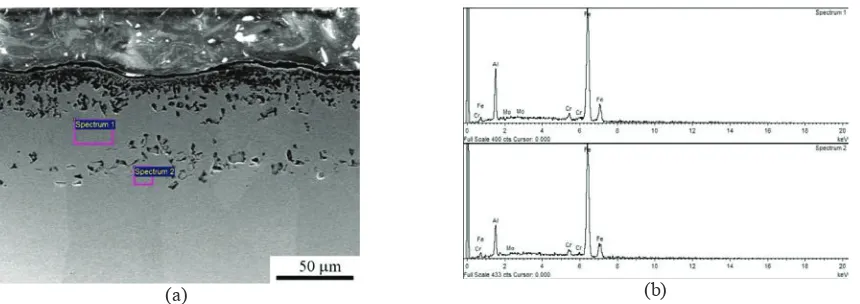High-temperature oxidation behavior of aluminized AISI 4130 steel
Mohammad Badaruddin, Chaur Jeng Wang, Herry Wardono, Tarkono, and Dwi Asmi
Citation: AIP Conference Proceedings 1711, 040002 (2016); doi: 10.1063/1.4941624 View online: http://dx.doi.org/10.1063/1.4941624
View Table of Contents: http://scitation.aip.org/content/aip/proceeding/aipcp/1711?ver=pdfcov Published by the AIP Publishing
Articles you may be interested in
High temperature oxidation behavior of austenitic stainless steel AISI 304 in steam of nanofluids contain nanoparticle ZrO2
AIP Conf. Proc. 1589, 187 (2014); 10.1063/1.4868779
High-temperature oxide thermoelectrics
J. Appl. Phys. 110, 053705 (2011); 10.1063/1.3626459
Electrical behavior of AlGaN/GaN heterostuctures upon high-temperature selective oxidation J. Appl. Phys. 106, 023703 (2009); 10.1063/1.3174438
High-temperature phase stability of hafnium aluminate films for alternative gate dielectrics J. Appl. Phys. 95, 3772 (2004); 10.1063/1.1652240
Influence of low energy–high flux nitrogen implantation on the oxidation behavior of AISI 304L austenitic stainless steel
J. Appl. Phys. 94, 7509 (2003); 10.1063/1.1629151
High-Temperature Oxidation Behavior of Aluminized
AISI 4130 Steel
Mohammad Badaruddin
1,a), Chaur Jeng Wang
3), Herry Wardono
1), Tarkono
1), and
Dwi Asmi
2)1Mechanical Engineering Department, Engineering Faculty, Lampung University 2Physics Department, Mathematics and Natural Sciences Faculty, Lampung University
Jalan Soemantri Brojonegoro No.1, Bandar Lampung 35145, Indonesia
3Mechanical Engineering Department, National Taiwan University of Science and Technology (NTUST)
43 Keelung Rd, Sec. 4, Taipei 106, Taiwan, ROC
aCorresponding author: [email protected]
Abstract.AISI 4130 steel was dipped into a molten aluminum bath at 700qC for 16 s to produce an aluminide coating on the steel substrate. The coating, which consisted of an Al-rich layer and an FeAl3and Fe2Al5intermetallic layer,
strongly adhered to the steel substrate. High-temperature oxidation of the bare steel and aluminized steel was performed by thermogravimetry at 850qC for 49 h in static air. The oxidation products were characterized by scanning electron microscopy and energy-dispersive spectroscopy. The aluminide coating could increase the oxidation resistance of the bare steel by a factor of ~19. The increase in high-temperature oxidation resistance of the aluminized steel is attributed to the formation of protective alumina scale (D-Al2O3). Although iron oxide nodules grew on the
aluminide coating surface, the oxidation rate of the aluminide coatings was very low. After 49 h of oxidation, agglomerates of Į-Al2O3fine grains grew on the rod-shaped FeAl phases.
INTRODUCTION
AISI 4130 steel containing 1.10 wt.%Cr and 0.25 wt.%Mo may be a candidate material for structural engineering components. CrMo steel alloys have been widely used as engineering components in power plants, incinerators, and in the petrochemical industry as boilers or heat exchangers for use at a working temperature of ~550°C [1,2]. However, chromia scale (Cr2O3) formed on CrMo steel alloys used at high working temperatures degrades rapidly because of
the formation of nonprotective iron oxide (Fe2O3) scale [3]. Consequently, the engineering components are severely
damaged under service conditions.
One technique for improving the oxidation resistance of steel at high temperatures is the use of hot-dipped aluminum coating. Studies on the oxidation behavior of hot-dipped aluminide steel have revealed that the steel after hot-dipped aluminum coating possesses higher isothermal oxidation resistance compared with that of steel with a chromia former [4,5]. The aluminide coating can protect the steel substrate from aggressive attack by oxidizing or corrosive gas in the environment by forming of a highly protective Al2O3layer during exposure to high temperatures
EXPERIMENTAL PROCEDURE
The substrates were cut into specimens with dimensions of 20 mm × 10 mm × 2 mm from commercial AISI 4130 steel. Before the aluminizing coating procedure, all specimens were ultrasonically etched with a solution of 5% NaOH for 30 s and then with 10% H3PO4 for 15 s. After the etching step, specimens were washed with water at a temperature
of <30°C. Immediately after washing, the etched specimens were subjected to uniform flux application using a welding Al flux. Each specimen was then dipped into a bath of molten 99.0 wt.%Al at 700°C. The specimens were moved at the appropriate speed by a hook made of stainless-steel wire to a crane system. After each specimen was immersed for 16 s, it was removed from the molten Al bath and then cooled in air at room temperature. The oxide flux thus formed on the surface of the aluminized specimen was then cleaned by using a nitric acid/phosphoric acid/water solution (1:1:1 v/v) at room temperature.
The oxidation kinetics of the uncoated and Al-coated specimens was separately studied by thermogravimetric analysis in ambient air at 850°C for at various times within 49 h. In order to investigate the oxidation behavior of aluminized AISI 4130 steel, Al-coated steel specimens were oxidized in a box furnace at 850°C at various times within 49 h and then air-cooled. The oxidation kinetics was monitored by plotting data for the weight gain (mg cmí2) versus
square root of time (se) curve. Samples were characterized by identifying structures of scale and phase formed by X-ray diffraction analysis in Bragg–Brentano configuration using monochromatic Cu-.ĮUDGLDWLRQDWN9DQG
mA. Furthermore, the surface morphology, cross sections, and element compositions (at.%) of the specimens were examined by scanning electron microscopy (SEM) using secondary electron image signals and energy-dispersive spectroscopy (EDS).
RESULTS AND DISCUSSION
Performance during High-Temperature Oxidation
A plot of the weight gain versus square root of time is displayed in Fig. 1. The oxidation resistance of the Al-coated specimen markedly increased at 850qC for 49 h because the protective Al-rich oxide layer (Al2O3) that formed
protected the steel from high-temperature oxidation. After 49 h of exposure to 850qC, the weight gain of the Al-coated steel and the bare steel was about 1.218 and 23.309 mg cmí2, respectively. According to linear regression results
(Fig. 1), the parabolic rate constant (kp) of bare steel is around 5.43 × 10í9mg2cmí4sí1during oxidation times ranging
from 3 to 16 h. If the kpvalue of the Al-coated steel is compared with the kpvalue of bare steel, then the kpvalue for
the Al-coated steel is two to four orders of magnitude lower than that for bare steel. The kpvalue for aluminized AISI
4130 steel in the present study is one to two orders of magnitude higher than those of Fe–Cr alloys with Al coating in other studies [4,5].
FIGURE 1.Weight gain versus square root of time for bare steel and for aluminized AISI 4130 steel after oxidation at 850qC for 49 h
As can be seen in Fig. 1, the oxidation kinetics of Al-coated steel during the 4 h oxidation period follows a parabolic trend, having akpvalue of 6.74 × 10í12mg2cmí4sí1. After >4 h of exposure, the oxidation rate of Al-coated steel
steadily decreased that was indicated by a decrease inkpvalue to 7.17 × 10í13mg2cmí4sí1. Furthermore, the weight
gain of Al-coated steel increased rapidly as the oxidation time increased to 15 h (Fig. 1). The kpvalue of Al-coated
040002-2
steel increased by two orders of magnitude (kp= 1.50 × 10í11mg2cmí4sí1) relative to that of oxidation rate of bare
steel. Although the surface of the aluminide layer of the Al-coated specimens was dense and compact, iron oxide nodules grew on the surface. Figure 2 shows a SEM micrograph of the surface morphology of the Al-coated steel after isothermal oxidation at 850°C in air. The iron oxide nodules began to grow on the aluminide coating at an oxidation time of 15 h. In this case, iron oxide nodules growing locally on the aluminide layer contributed to an increase in the oxidation rate of Al-coated steel. Similar cases of oxidation of mild steel with a hot-dipped aluminum coating and exposed to 850°C in dry air [6] and to 750°C in a steam environment [7] have been reported.
FIGURE 2.Surface morphology of the Al-coated specimen following oxidation at 850qC for 15 h showing the growth of iron oxide nodules
As shown by the SEM micrograph in Fig. 2, iron oxide nodules were found on the aluminide coating layer. However, not all of the nodules were located on the surface of the aluminide coating. Breakdown oxidation in Fig. 1 may be due to sporadic growth of iron oxide nodules. Iron oxide nodules can grow on the surface of the aluminide coating in two ways: (1) Oxygen penetrating the steel substrate via crack paths and steel substrate is oxidized directly by oxygen [6].$OேYDFDQFy defects in alumina scale allow outward diffusion of Fe2+through Al2O3via aluminum
vacancies; subsequently, iron oxidation mechanism dominates and forms iron oxide nodules [7].
Microstructures Observation and Characterization
The cross-sectional micrograph of the aluminide layer after the aluminizing process is shown in Fig. 3a. The thickness of the aluminide coating is about 24 μm, 18 μm of which consists of FeAl3and Fe2Al5layers. No cracks or
dense structures could be observed in the aluminide layer on the steel substrate. According to EDS analysis, the Al, Fe, Cr compositions (at.%) of FeAl3and Fe2Al5were 80.11, 19.8, and 0.09 and 69.29, 30.31, and 0.39, respectively.
The flat Fe2Al5structure at the interface had a phase containing a low concentration of Cr [8].
In order to understand the high-temperature oxidation behavior of aluminized AISI 4130 steel, the Al-coated steel specimens were isothermally oxidized at 850°C for various durations within 49 h. The SEM micrograph of the cross-sectional Al-coated steel specimen after 1 h of oxidation shows that the Al and FeAl3layers of the as-coated specimen
disappeared and transformed into Fe2Al5and FeAl2(Fig. 3b). Moreover, FeAl–Cr precipitates with high Cr content
could be observed in the Fe2Al5and FeAl2layers. These precipitates were generated by rapid dilution of the Fe-rich
region due to diffusion coupling between internal Al atoms and external Fe atoms. Al, Fe, and Cr, compositions (at.%) of the FeAl–Cr precipitate were 41.19, 55.38, and 3.43, respectively. No molybdenum could detected by EDS analysis. Some voids that formed and dispersed in the outer aluminide layer can also be observed in Fig. 3b. Phase transformation during oxidation at high temperatures induced by the volume change of intermetallic phases contributed to void formation [9].
It also can be observed in Fig. 3c and 3d that the Fe2Al5/FeAl2layer dominantly formed in the aluminide layer,
whereas a thin FeAl layer formed on the steel substrate. The result for EDS oxygen mapping (Fig. 3e) indicates that a very thin Al2O3 layer formed in the outer aluminide layer with Fe atoms dissolved in the alumina scale after an
oxidation time of 1 h. Some voids that formed in the outer aluminide layer show that aluminum atoms in the Fe2Al5
phase diffused outward and subsequently contributed to Al2O3formation (Fig. 3e). EDS analysis of the spectrum of
(a)
(c)
(e)
(b)
(d)
(f)
FIGURE 3.SEM micrographs of (a) the as-coated steel and of (b) the Al-coated specimen oxidized for 1 h. (cf) EDS elemental maps for Al, Fe, O and Cr in the specimen in part b
Phase transformation and microstructure evolution behaviors of the aluminide layer on the hot-dipped aluminized CrMo steel after isothermal oxidation for shorter time were examined. Fe2Al5, FeAl2, and FeAl were precipitates
with high Cr content in the FeAl–Cr phase in the aluminide coating [9]. As the oxidation time increased to 36 h, aluminum atoms diffused rapidly into the steel substrate, resulting in a decrease in their concentration. The Fe2Al5
phase was replaced by FeAl2and FeAl phases via interdiffusion between internal Al atoms and external Fe atoms
from the substrate. The SEM cross-sectional micrograph of the Al-coated specimen oxidized at 850°C for 36 h and its corresponding EDS line profiles of Fe, Al, O, Cr, and Mo distributions across the coating layer on the steel substrate are depicted in Fig. 4. The two distinct phases in the aluminide layer consisted of FeAl, FeAl2, and a thin Al2O3scale.
The composition of iron atoms in the Al2O3scale ranged from 9.1 to 11.3 at.%, and that of Cr atoms was only ~0.66
at.%. Both Fe and Cr are well-known metals that support rapid formation of very stable D-Al2O3[2,4,10].
040002-4
(a)
(b)
FIGURE 4.(a) SEM cross-sectional micrograph of Al-coated specimen oxidized at 850°C for 36 h and (b) its corresponding EDS line profiles of Fe, Al, Cr, O, and Mo
(a) (b)
FIGURE 5.(a) SEM cross-sectional micrograph of the aluminide coating on AISI 4140 steel after isothermal oxidation at 850°C for 49 h and (b) EDS spectra for Fe, Al, Cr, and Mo
Cross-sectional SEM micrographs of aluminide steel (Fig. 5a) and EDS results (spectrum 1, Fig. 5b) from phase-constitution analysis reveal that the major phase in the aluminide layer as the oxidation time increased to 49 h was Fe3Al with Al, Fe, Cr, and Mo compositions (at.%) of 25.10, 72.61, 2.05, and 0.23, respectively. EDS spectrum 2
(Fig. 5b) shows that the aluminide layer contains 18.91, 78.50, 2.32, and 0.27 at.%, Al, Fe, Cr, and Mo, respectively. These results show that longer oxidation time led to lower content of aluminum atoms of the aluminide layer on the steel substrate.
Figure 6 shows the surface SEM morphology of the oxide scales formed on the Al-coated specimen after air oxidation at 850°C for 49 h. There were two different structures of Al2O3scales on the surface: D-Al2O3with iron
oxide nodules on the aluminide layer (Fig. 6a) and D-Al2O3agglomerates on rod-shaped FeAl precipitates (Fig. 6b)
formed in different areas. EDS analysis showed that the Cr and Fe content in the area of the agglomerates was 0.22 and 2.20 at.%, respectively. Those in the area of D-Al2O3 on the aluminide surface were 0.21 and 7.09 at.%,
respectively. The surface morphology of the alumina scale is dense. Although iron oxide nodules also grew on the aluminide surface, the aluminide coating on the AISI 4130 steel underwent very slow oxidation. Agglomerates of the
D-Al2O3phase only grew on the rod-shaped FeAl precipitates after 49 h of oxidation. The rod-shaped FeAl phase
resulted from the transformation of the FeAl2phase due to Al consumption.D-Al2O3agglomerates grew relatively
fast in the rod-shaped FeAl phase because of the high diffusivity of Al3+during outward transport via screw dislocation
(a) (b)
FIGURE 6.(a) SEM surface morphology of the Al-coated specimen and (b) D-Al2O3agglomerates growing on the rod-shaped FeAl phases after isothermal oxidation at 850qC for 49 h
CONCLUSIONS
A hot-dipped aluminum coating has been applied to AISI 4130 steel to improve its oxidation resistance at 850qC. The oxidation kinetics follows a parabolic law, which is evident in the diffusion-controlled formation of the intermetallic phase consisting of Fe2Al5, FeAl2, FeAl, and FeAl-Cr precipitates, as well as in the formation of the
surface morphology of alumina scale. The aluminide coating provides good protection for the steel substrate by forming a protective alumina scale. The rate for the Al-coated steel is two to four orders of magnitude lower than that for bare steel. After oxidation at 850°C for 49 h, a fully dense and continuous alumina scale formed on the surface of the aluminide coating. Agglomerates of Į-Al2O3fine grains on the rod-shaped FeAl phase are attributed to the fast
outward diffusion of Al atoms via screw dislocation.
ACKNOWLEDGMENT
The authors would like to thank to the Ministry of Research, Technology and Higher Education of the Indonesian Republic for funding support via the Grant Research of National Strategy under contract no. 153/UN26/8/LPPM/2015.
REFERENCES
1. R. K. S. Raman and A. Al-Mazrouee,Metall. Maters. Transactions A38, 17501759 (2007). 2. N. J. Simms and J. A. Little, Oxid. Metals27, 283299 (1987).
3. R.V. Kumar, V. K. Tewari and S. Prakash, Metall. Maters Transactions A38, 5457 (2007). 4. D. B. Lee, G. Y. Kim and J. G. Kim,Maters. Sci. Engineering A339, 109116 (2003). 5. Y. Y. Chang, W. J. Cheng and C. J. Wang,Maters. Characterization60, 144149 (2009). 6. C. J. Wang and S. M. Chen, Surf. Coat. Technology200, 66016606 (2006).
7. C. J. Wang and M. Badaruddin,Surf. Coat. Technology205, 12001205 (2010). 8. W. J. Cheng and C. J. Wang, Appl. Surf. Science277, 139– 145 (2013). 9. W. J. Cheng and C. J. Wang,Maters. Characterization61, 467472 (2010). 10. Z. Zhan, Y. He, D. Wang and W. Gao,Oxid. Metals68, 243–251 (2007).
040002-6




